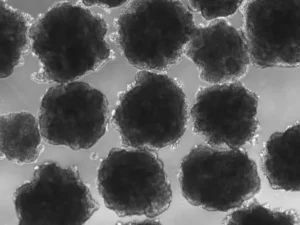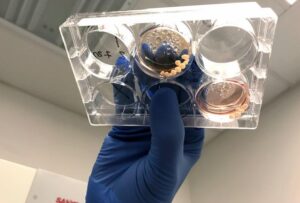
Southern Cross University—A groundbreaking international study* changes the view that exposure to the toxic metal lead is largely a post-industrial phenomenon. The research reveals that our human ancestors were periodically exposed to lead for over two million years, and that the toxic metal may have influenced the evolution of hominid brains, behaviour, and even the development of language.
Moreover, the study – published in Science Advances – adds a piece to the puzzle of how humans outcompeted their cousins, the Neanderthals. Brain organoid models with Neanderthal genetics were more susceptible to the impacts of lead than human brains, suggesting that lead exposure was more harmful to Neanderthals.
Led by researchers from the Geoarchaeology and Archaeometry Research Group (GARG) at Southern Cross University (Australia), the Department of Environmental Medicine at the Icahn School of Medicine at Mount Sinai Hospital (New York, USA), and the School of Medicine at the University of California San Diego (UCSD, USA), the research combined novel fossil geochemistry, cutting-edge brain organoid experiments, and pioneer evolutionary genetics to uncover a surprising story about lead’s role in human history.
A toxic thread through human evolution
Until now, scientists believed lead exposure was largely a modern phenomenon, linked to human activities such as mining, smelting, and the use of leaded petrol and paint. By analysing 51 fossil teeth from hominid and great ape species, including Australopithecus africanus, Paranthropus robustus, early Homo, Neanderthals, and Homo sapiens, the team discovered clear chemical signatures of intermittent lead exposure stretching back almost two million years.
Using high-precision laser-ablation geochemistry at Southern Cross University’s GARG Facility (located in Lismore, NSW) and Mount Sinai’s Exposomics state-of-the-art facilities, the researchers found distinctive ‘lead bands’ in the teeth, formed during childhood as the enamel and dentine grew. These bands reveal repeated episodes of lead uptake from both environmental sources (such as contaminated water, soil, or volcanic activity) and from the body’s own bone stores, released during stress or illness.
“Our data show that lead exposure wasn’t just a product of the Industrial Revolution – it was part of our evolutionary landscape,” said Professor Renaud Joannes-Boyau, Head of the GARG research group at Southern Cross University.
“This means that the brains of our ancestors developed under the influence of a potent toxic metal, which may have shaped their social behaviour and cognitive abilities over millennia.”
From fossils to function: lead and the language gene
The team also turned to the lab to explore how this ancient exposure might have affected brain development. Using human brain organoids, miniature, lab-grown models of the brain, they compared the effects of lead on two versions of a key developmental gene called NOVA1, a gene known to orchestrate gene expression upon lead exposure during neurodevelopment. The modern human version of NOVA1 is different from that found in Neanderthals and other extinct hominids, but until now, scientists did not know why this change evolved.
When organoids carrying the archaic NOVA1 variant were exposed to lead, they showed marked disruptions in the activity of FOXP2 – expressing neurons in the cortex and thalamus – brain regions that are critical for the development of speech and language. This effect was far less pronounced in organoids with the modern NOVA1 variant.
“These results suggest that our NOVA1 variant may have offered protection against the harmful neurological effects of lead,” said Professor Alysson Muotri, Professor of Pediatrics/Cellular & Molecular Medicine and Director of the UC San Diego Sanford Stem Cell Institute Integrated Space Stem Cell Orbital Research Center.
“It’s an extraordinary example of how an environmental pressure, in this case, lead toxicity, could have driven genetic changes that improved survival and our ability to communicate using language, but which now also influence our vulnerability to modern lead exposure.”
Genetics, neurotoxins, and the making of modern humans
Genetic and proteomic analyses in this study revealed that lead exposure in archaic-variant organoids disrupted pathways involved in neurodevelopment, social behaviour, and communication. The altered FOXP2 activity in particular points to a possible link between ancient lead exposure and the evolutionary refinement of language abilities in modern humans.
“This study shows how our environmental exposures shaped our evolution,” said Professor Manish Arora, Professor and Vice Chairman of Environmental Medicine.
“From the perspective of inter-species competition, the observation that toxic exposures can offer an overall survival advantage offers a fresh paradigm for environmental medicine to examine the evolutionary roots of disorders linked to environmental exposures.”
Modern lessons from an ancient problem
While lead exposure today is mostly due to human industry, it remains a serious global health issue, particularly for children. The findings underscore how deeply intertwined environmental toxins and human biology have been and warn that our vulnerability to lead may be an inherited legacy of our past.
“Our work not only rewrites the history of lead exposure,” added Professor Joannes-Boyau, “it also reminds us that the interaction between our genes and the environment has been shaping our species for millions of years, and continues to do so.”
_______________________________

Using human brain organoids (miniature, lab-grown models of the brain), the team compared the effects of lead on two versions of a key developmental gene called NOVA1, a gene known to orchestrate gene expression upon lead exposure during neurodevelopment. The modern human version of NOVA1 is different from that found in Neanderthals and other extinct hominids. University of California San Diego
_______________________________

Laboratory experiments with brain organoids carrying either modern or archaic NOVA1 genes examined the effects of lead on brain development, with a focus on FOXP2, a gene central to speech and language. University of California San Diego
_______________________________
About the research
The study analysed fossil teeth from Africa, Asia, Europe, and Oceania, using advanced geochemical mapping to identify patterns of childhood lead exposure. Laboratory experiments with brain organoids carrying either modern or archaic NOVA1 genes examined the effects of lead on brain development, with a focus on FOXP2, a gene central to speech and language. Genetic, transcriptomic, and proteomic data were integrated to build a comprehensive picture of how lead may have influenced the evolution of hominid social behaviour and cognition.
_______________________________
Article Source: Southern Cross University news release.
*Impact of intermittent lead exposure on hominid brain evolution, 15-Oct-2025,10.1126/sciadv.adr1524 15-Oct-2025




